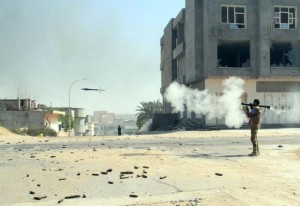Libyan pro-government forces have cornered Islamic State group fighters in a few pockets of Sirte, but defeat there will be far from the end of IS in Libya, analysts say.
While ousting the jihadists from the coastal city that was once their North African stronghold would be a symbolic boost for Libya’s fragile unity government, it could also set the stage for further conflict.
“Daesh has lost Sirte, but it has not lost Libya,” said Abdelbari Atwan, a journalist and expert on jihadist groups, using an Arabic acronym for IS.
The loss of its main stronghold could prompt the group to launch more scattered attacks across the country, which remains an important recruitment base for IS.
It took over Sirte and a stretch of Libyan coastline in June 2015. With that, IS gained a foothold — and a major port — just 300 kilometres (180 miles) from the European coast.
Forces commanded by Libya’s Government of National Accord (GNA) launched an offensive on May 12 to oust the jihadists.
GNA forces entered Sirte on June 9 and began a street-by-street battle against jihadist snipers, also facing car bombs and suicide attacks. Backed by US air strikes, they took over an IS command centre on August 11.
– Melting away –
Defeat for IS in Sirte would come on top of significant losses the jihadist group has suffered in Iraq and Syria.
It would probably prompt the group to change tactics, said Ethan Chorin, an American former diplomat in Libya and head of Perim Associates, a consultancy.
Libya will “very likely see a shift in IS strategy to a more diffuse and intensified campaign of terror and intimidation,” he told AFP.
“IS and like-minded Islamist fighters have consistently shown an ability to ‘melt away’ at will,” Chorin said.
It is hard to estimate the number of IS fighters still alive in Sirte. The Pentagon estimates that they number in the hundreds.
According to French and American sources, a further 5,000-7,000 are present across Libya.
While the loss of Sirte would deprive them of a strategically valuable port, they could move to set up a base in the lawless deserts of southern Libya.
“It is a porous region, as the central state has no presence there and no single militia dominates,” said Atwan.
He noted that several major tribes which supported the toppled regime of dead dictator Moamer Kadhafi are marginalised today, spurring some of their young men to join IS.
“Those people found a refuge in the Islamic State,” he said.
– Political victory? –
A victory in Sirte would still be a boost for the GNA, Libya’s internationally recognised government, particularly as it competes for legitimacy against a rival administration in the country’s east.
Chorin warned that the GNA and its allied militias may embark on a showdown with the eastern-based Libyan National Army over Libya’s oilfields in the Sirte Basin.
“It is very possible we are seeing the start of an even larger conflict,” he said.
Meanwhile, it is a welcome development for the GNA, which enjoys scant popular support.
Four months after prime minister-designate Fayez al-Sarraj set up his administration in Tripoli, public services are close to collapse and the country faces a currency crisis.
Chronic security problems also reign across Libya, which has largely been ruled by militias since the fall of the Kadhafi regime in 2011.
Indeed, there are no guarantees that the GNA, which leaned heavily on powerful militias from nearby Misrata in the fight for Sirte, will retain their loyalty once that battle is over.
“It is likely that the victorious militias will defy GNA rulings and expose the fact that the GNA is not actually a unity of anything,” said Jason Pack, a Libya-focused researcher at Cambridge University who consults for Western governments.
“As always in Libya, it is the men with guns who hold political power, not those with fancy suits and titles.”
digitaljournal.com



